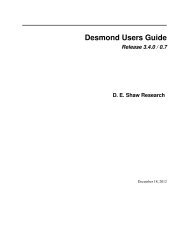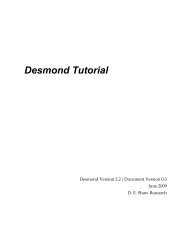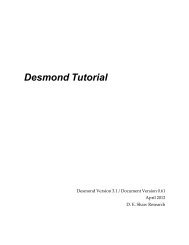Desmond Tutorial
Desmond Tutorial - DE Shaw Research
Desmond Tutorial - DE Shaw Research
- No tags were found...
Create successful ePaper yourself
Turn your PDF publications into a flip-book with our unique Google optimized e-Paper software.
Preparing a <strong>Desmond</strong> simulation with the System Builder<br />
Setting Up Membrane Systems<br />
— my_setup.csb. This is the command file, which can be hand‐edited for custom<br />
setup cases. For detailed documentation of the .csb file see the Schrödinger <strong>Desmond</strong><br />
User Manual listed in “Documentation Resources” on page 97.<br />
And a single output file (besides a log file):<br />
— my_setup-out.cms. This is the Maestro structure file of the entire simulation<br />
system including OPLS‐AA force field parameters. For details on the .cms file see<br />
the Schrödinger <strong>Desmond</strong> User Manual listed in “Documentation Resources” on<br />
page 97.<br />
2. Execute the following command at the command line:<br />
$ $SCHRODINGER/run $SCHRODINGER/utilities/system_builder<br />
my_setup.csb<br />
where my_setup is the file name given to “Write”.<br />
Setting Up Membrane Systems<br />
The Membrane tab as shown in Figure 4.4 can be used to embed a membrane protein structure<br />
in a membrane bilayer. In this procedure a template consisting of an equilibrated<br />
membrane—including the accompanying water—is used to generate a large enough<br />
region to encompass the protein. Using the Membrane tab, you can position the protein<br />
within the membrane using a semi‐automated procedure.<br />
Figure 4.4 Membrane setup in the System Builder<br />
As a real‐life example we can consider the calcium ATPase protein, 1su4. Follow the procedure<br />
below to prepare this protein for membrane simulation in <strong>Desmond</strong>.<br />
To setup the 1su4 membrane protein system for <strong>Desmond</strong> simulation:<br />
1. Open the Protein Preparation Wizard by selecting Workflows > Protein Preparation<br />
Wizard. Type “1su4” in the PDB field and click the Import button as shown in<br />
Figure 4.5.<br />
2. When the structure appears in the MaestroWorkspace, set the preprocessing options<br />
as shown in Figure 4.5; do not delete the crystal waters as they are integral to the pro‐<br />
September 2008 D. E. Shaw Research 47






